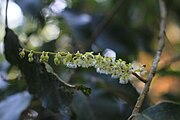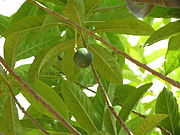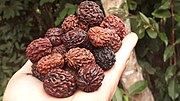Rudraksha beads are categorized based on the number of faces they possess, ranging from 1 to 21, with rare occurrences of beads having up to 26-27 faces.[42] Additionally, unique types such as Gaurishankar (two beads conjoined), Trijuti (three beads conjoint),veda (4 conjoined sawars) and dwaita (2 conjoined sawars) are also found among the variety of Rudraksha beads available.
Some faces or mukhi are exclusive or rarest on earth, making them challenging to find. These rare Rudraksha beads hold immense significance and are believed to possess potent energies and blessings, making them highly sought after by spiritual practitioners and collectors alike. Each Mukhi holds a unique vibration, guiding seekers on their spiritual journey towards inner awakening and enlightenment. By chanting the Beej mantras corresponding to each Rudraksha Mukhi, practitioners can tap into the inherent power of these sacred beads, fostering a deeper connection to the divine and unlocking hidden potentials within themselves.[43]
One Mukhi Rudraksha: Known as the rarest and most potent bead. This 1 Mukhi Rudraksha bead symbolizes the formless, absolute reality – the soul. Bestows concentration, focus and spiritual growth.
Two Mukhi Rudraksha: Represents Ardhanarishvara, the combined form of Shiva and Shakti. The 2 Mukhi Rudraksha harmonizes relationships and enhances unity. Ideal for couples seeking marital bliss.
Three Mukhi Rudraksha: Associated with the trinity of Brahma, Vishnu and Shiva. Wearing 3 Mukhi Rudraksha brings peace, tranquility and spiritual advancement. Ideal for meditation and self-discovery.
Four Mukhi Rudraksha: Symbolizes the four Vedas. Enhances knowledge, creativity and communication. 4 Mukhi Rudraksha is beneficial for students and professionals.
Five Mukhi Rudraksha: Represents the five elements and five senses. Wearing 5 Mukhi Rudraksha promotes good health, mental stability and spiritual growth. Commonly used for daily prayers and meditation.
Six Mukhi Rudraksha: Connected to Kartikeya, the son of Shiva. The 6 Mukhi Rudraksha enhances willpower, focus and intellect. Beneficial for professionals seeking career success.
Seven Mukhi Rudraksha: Represents Goddess Mahalakshmi. Wearing 7 Mukhi Rudraksha bestows wealth, prosperity and success in business. Alleviates financial worries.
Eight Mukhi Rudraksha: Linked to Lord Ganesha, 8 Mukhi Rudraksha removes obstacles, brings success and enhances leadership qualities. Worn for overcoming challenges in life.
Nine Mukhi Rudraksha: Associated with Goddess Durga, 9 Mukhi Rudraksha provides strength, courage and protection. Guards against negative energies.
Ten Mukhi Rudraksha: Represents Lord Vishnu, 10 Mukhi Rudraksha bestows divine protection and enhances positivity. Ideal for those seeking spiritual awakening.
Eleven Mukhi Rudraksha: Associated with Lord Hanuman, the 11 Mukhi Rudraksha instills strength, courage, and devotion. It aids in overcoming obstacles and challenges, promoting success and victory in endeavors.
Twelve Mukhi Rudraksha: Symbolizing the twelve Adityas, the 12 Mukhi Rudraksha bestows vitality, charisma, and leadership qualities. It enhances creativity and decision-making abilities, fostering success and recognition.
Thirteen Mukhi Rudraksha: Linked to Lord Kamadeva, the 13 Mukhi Rudraksha enhances charm, attraction, and magnetism. It promotes love, romance, and harmonious relationships, fostering emotional well-being and fulfillment.
Fourteen Mukhi Rudraksha: Associated with Lord Shiva's grace and protection, the 14 Mukhi Rudraksha enhances spiritual awareness, provides protection from negative energies, and facilitates meditation. It promotes healing, balance, and harmony in life.
Fifteen Mukhi Rudraksha: Symbolizing Lord Pashupatinath, the 15 Mukhi Rudraksha bestows divine grace, blessings, and spiritual enlightenment. It enhances intuition, wisdom, and psychic abilities, fostering spiritual growth and transformation.
Sixteen Mukhi Rudraksha: Associated with Lord Rama, the 16 Mukhi Rudraksha enhances courage, righteousness, and inner strength. It promotes self-discipline, determination, and victory over adversities, fostering success and prosperity.
Seventeen Mukhi Rudraksha: Symbolizing Goddess Katyayani, the 17 Mukhi Rudraksha bestows divine blessings, protection, and strength. It enhances fertility, motherhood, and nurturing qualities, fostering family harmony and well-being.
Eighteen Mukhi Rudraksha: Linked to Bhumi Devi, the 18 Mukhi Rudraksha enhances grounding, stability, and abundance. It promotes prosperity, growth, and success in endeavors, fostering material and spiritual wealth.
Nineteen Mukhi Rudraksha: Associated with Lord Narayana, the 19 Mukhi Rudraksha bestows divine blessings, protection, and fulfillment of desires. It enhances devotion, faith, and spiritual connection, fostering divine grace and blessings.
Twenty Mukhi Rudraksha: Symbolizing Vishwasu Sadhu and Vasuki, the 20 Mukhi Rudraksha enhances intuition, psychic abilities, and spiritual enlightenment. It promotes divine knowledge, wisdom, and inner peace, fostering spiritual growth and liberation.
Twenty-One Mukhi Rudraksha: Linked to Lord Kuber and Ek Alakh Niranjan, the 21 Mukhi Rudraksha bestows divine blessings, prosperity, and abundance. It enhances material wealth, success in endeavors, and fulfillment of desires, fostering financial stability and prosperity.



















